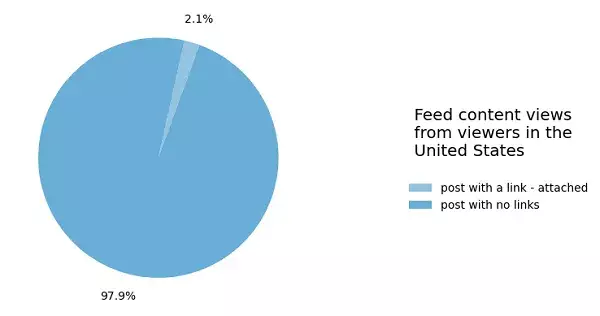With each quarterly report, Meta unpacks a trove of data reflecting the dynamics of user engagement, content violations, and the broader implications of platform policies. The latest release for Q4 2024 presents critical insights into how users interact with content on Facebook, showcases alarming trends regarding external links, and reveals the complexities surrounding content moderation.
The figures presented in the Q4 2024 report are a wake-up call for content creators and publishers alike. An alarming 97.9% of the Facebook content views in the U.S. lacked links to external sources. This suggests that most users are consuming content that is native to the platform, effectively creating an insular ecosystem where external contributions are marginal at best. This trend is not an overnight development; it reflects a consistent decline from 86.5% in Q3 2021, indicating a growing reluctance among users to engage with content that leads them away from Facebook.
This shift not only affects the visibility and traffic of external content but also alters user behavior on social media. Publishers who rely on Facebook as a traffic source may find their strategies obsolete as Meta continues to prioritize in-app engagement over external link sharing. The implications are profound: a fundamental change in how information is disseminated could limit the diversity of viewpoints available to users and hinder the growth of independent journalism, reinforcing a form of media gatekeeping.
When examining the nature of the most viewed Facebook posts, the data reveals a striking preference for content that hovers around celebrity culture and sensationalism. From heartwarming Christmas stories involving celebrities to mundane posts featuring influential figures, the content that garners attention seems to tread more toward the frivolous than the substantive. While these stories might engage users on an emotional level, they often lack the profound societal discourse that is necessary for informed public dialogue.
Relying on this formula for engagement may further entrench a culture where superficial content reigns supreme, pushing critical thinking and important issues to the periphery of Facebook feeds. This creates a feedback loop that perpetuates the popularity of lifestyle and celebrity-oriented narratives while undervaluing in-depth reporting and discourse, consequently diminishing the platform’s potential as an information resource.
According to Meta’s report, the prevalence of violent and graphic content has risen on platforms like Instagram, coinciding with shifts in their content moderation techniques. Although Meta did not record any significant spikes in the overall violations during the quarter, a cautionary note echoes through the report regarding the increasing presence of such content, particularly as Meta reassesses its processes for detecting and managing violations.
The data also indicates that fake accounts accounted for approximately 3% of global monthly active users in Q4, a slight reduction from the previously accepted 5%. While this might suggest improved efficacy in identifying and creating proactive measures against inauthentic accounts, it is also pertinent to question the reliability of these figures in the absence of a definitive industry standard for measuring fake accounts.
Meta’s adjustments in content policy—including the controversial shift to a Community Notes model and alterations regarding hate speech standards—are poised to impact user trust and content moderation effectiveness. Despite reporting a decrease in enforcement errors, one must consider the broader implications: is a reduction in errors inherently indicative of effective moderation, or does it simply illustrate a reduced level of oversight?
The move to lessen the role of active monitoring, particularly concerning politically sensitive topics, raises questions about the extent to which harmful content could become more prevalent. The notion that enforcement actions may remain steady despite a more lax approach is speculative at best, potentially concerning to stakeholders invested in maintaining a safe and equitable online community.
The Q4 report also sheds light on the evolving landscape of influence operations. With mentions of ongoing efforts by groups like the Russian operation termed “Doppelganger”, the report serves as a stark reminder of external threats that continue to manipulate platform dialogue. The fact that targeting toward the U.S. and Ukraine has decreased may hint at a strategic pivot, favoring other regions like Germany and France instead.
This evolution indicates that users and regulators alike must stay vigilant. The potential for these operations to morph and adapt should alert all stakeholders to the need for stringent monitoring and a proactive approach to counter misinformation and manipulation.
As Meta navigates the complexities of platform governance and user engagement, the Q4 2024 report encapsulates a moment of reflection for both the company and its users. With the persistent dominance of insular content, a shift in moderation practices, and emergent threats, stakeholders are compelled to question how these dynamics will shape the future of online discourse. Only time will tell if Meta can adapt to these challenges while fostering a space conducive to genuine engagement and informed public dialogue.

